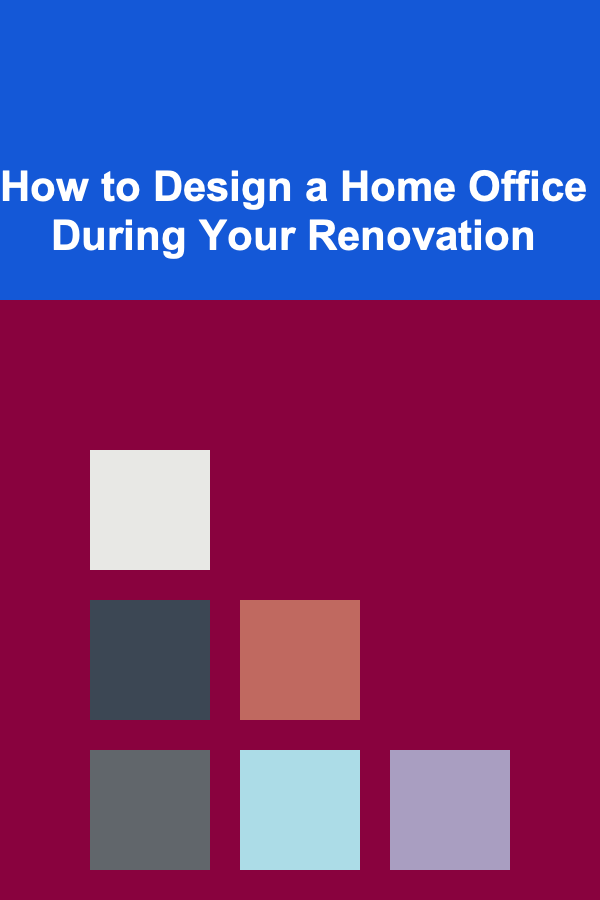
How to Design a Home Office During Your Renovation
ebook include PDF & Audio bundle (Micro Guide)
$12.99$6.99
Limited Time Offer! Order within the next:

In recent years, the concept of remote work has gained immense popularity, with many professionals choosing to work from the comfort of their own homes. Whether you're self-employed, working for a company, or pursuing freelance opportunities, having a designated home office is essential for productivity, focus, and work-life balance. If you're planning a home renovation, it's the perfect opportunity to design a home office that meets both your functional and aesthetic needs. This article will guide you through the process of designing a home office during a renovation, covering everything from space planning to furniture selection, lighting, storage, and décor.
Understanding the Importance of a Dedicated Home Office
A home office is more than just a desk and a chair. It's a space where you'll spend hours of your day working, making decisions, collaborating with others, and sometimes even hosting meetings. Having a designated, organized, and comfortable space can significantly enhance productivity and help you separate work from personal life, especially if you're balancing both under one roof. Additionally, a well-designed office will serve as a representation of your professionalism, even if you're working remotely.
The Benefits of a Well-Designed Home Office
- Productivity Boost: A functional workspace that caters to your work style can significantly increase your efficiency and output. A clutter-free, well-lit, and ergonomic workspace can enhance focus and reduce distractions.
- Work-Life Balance: Having a dedicated space for work allows you to mentally "switch off" from the office once your workday is over, creating a clearer boundary between professional and personal time.
- Increased Comfort: Whether you're working at a computer for extended hours or holding meetings, comfort is key. Proper seating, desk height, and an environment conducive to concentration will make working from home more enjoyable.
- Professionalism: For those who meet clients or colleagues over video calls, having a well-organized and visually appealing home office can help project professionalism.
Step 1: Assessing Your Space
Before diving into the design process, it's important to assess the space you have available for your home office. Whether you're converting a spare bedroom, repurposing a corner of the living room, or creating an entirely new room in your renovation, understanding your available space is crucial in designing a functional home office.
Consider Your Work Needs
The first step in determining how much space you need is to evaluate your work needs. What type of work do you do? Do you need space for paperwork, books, or multiple monitors? Are you working on creative tasks that require ample space for tools, materials, or designs? Consider your daily activities and how much space you require to accomplish them.
- Small Spaces: If your available space is limited, consider a compact desk, wall-mounted shelves, or multi-functional furniture that can be easily tucked away when not in use. A corner of your living room or bedroom might be an excellent spot for a minimalist home office.
- Larger Spaces: If you have a room dedicated solely to your home office, you have more flexibility in terms of layout and design. You may be able to incorporate a larger desk, comfortable seating, a filing cabinet, and even room for meeting areas.
Natural Light and Ventilation
When selecting a space for your office, prioritize areas with natural light. Exposure to sunlight has been shown to boost mood, improve focus, and regulate circadian rhythms, all of which contribute to a productive work environment. If your renovation allows, consider installing large windows, or ensuring that your desk is placed near a light source.
Additionally, good ventilation is essential. Ensure your home office has proper airflow to prevent a stuffy, uncomfortable environment. This may involve installing a fan or opening windows to keep the air fresh.
Privacy and Noise Control
Another important consideration is privacy. When designing your home office, think about whether you'll need to make private calls, host video meetings, or concentrate without distraction. If your home office is in an open or shared area, consider adding a partition, installing soundproofing materials, or using noise-canceling headphones to minimize disruptions.
Step 2: Choosing the Right Furniture
Once you've assessed the space and are clear on your needs, it's time to focus on furniture. The right furniture not only supports productivity but also adds to the aesthetic and comfort of the room. Here are some key pieces of furniture you should consider when designing your home office:
Desk
The desk is the centerpiece of any home office. When choosing a desk, consider the following factors:
- Size: Choose a desk that fits the available space without overwhelming the room. If you're working with limited space, a compact desk with a built-in shelf or storage could be ideal.
- Storage: Look for desks that offer drawers or shelves for storing essential items like pens, documents, and tech accessories. If you have a large workload, you may want a desk with a combination of open shelves and closed drawers to help keep things organized.
- Style: The desk should align with the overall design aesthetic of the room. Whether you prefer a sleek modern desk or a vintage-style wooden desk, the desk should enhance the room's look and feel.
Chair
Since you'll likely be spending hours sitting at your desk, comfort is a priority when selecting an office chair. An ergonomic chair with adjustable height, lumbar support, and armrests will ensure that you're comfortable and maintain good posture throughout your workday. Choose a chair that supports your body, promotes proper alignment, and suits your design preferences. Look for high-quality fabrics or leather finishes that complement the other furniture in the room.
Storage Solutions
Proper storage is essential to avoid clutter. When planning your home office design, think about how you can store everything you need within reach, while maintaining an organized and tidy workspace. Here are some options:
- Bookshelves: Open shelving can add both functionality and style. If you have a lot of books or need to store items such as binders or files, bookshelves are an ideal solution. For a modern twist, you can also install floating shelves.
- Filing Cabinets: For paperwork, documents, and files, a filing cabinet can help you stay organized. Choose a cabinet that fits the space and adds to the aesthetic. Some people opt for stylish, vintage-inspired cabinets, while others choose sleek modern designs.
- Storage Bins: Invest in bins or baskets for smaller items that tend to pile up, such as office supplies, stationery, or tech gadgets. These can be placed under desks or in closets to keep the room tidy.
Step 3: Optimizing the Layout
The layout of your home office is essential for maintaining productivity and comfort. A good layout ensures that everything is within reach and allows for smooth workflow. The ideal layout depends on the size and shape of your space, but here are some tips to optimize your home office layout:
Desk Placement
The placement of your desk can make a significant difference in both functionality and comfort. The most common options are:
- Facing the Window: If you have a window with a beautiful view, placing your desk facing it can help you enjoy natural light and create a positive work environment. Just be mindful of glare on your computer screen, which can be mitigated with window treatments like shades or curtains.
- Against the Wall: Placing your desk against a wall is a good option if you need privacy and less distraction. This layout can create a more focused, quiet atmosphere.
- Facing the Door: For those who want a sense of control and authority, positioning the desk so that you face the door is an effective way to feel more organized. However, be mindful that it may increase distractions.
Workflow and Movement
Ensure that the desk, storage, and seating areas are arranged to allow for smooth workflow. For example, place items you use frequently, like pens or notebooks, within easy reach. Keep your chair in a position where you can swivel easily to access your file cabinets, bookshelves, or other storage areas.
Additionally, think about how you move around the room. Avoid overcrowding the space with furniture, as this can make it feel cramped and uncomfortable.
Step 4: Lighting Your Home Office
Good lighting is essential for creating a productive and comfortable work environment. There are several types of lighting you'll need to consider for your home office design:
Ambient Lighting
Ambient lighting is the primary light source in a room. It should be soft and even, allowing you to see clearly without straining your eyes. This can come from ceiling lights, overhead fixtures, or wall-mounted lights. If possible, use energy-efficient LED lights, as they offer excellent lighting and consume less energy.
Task Lighting
Task lighting is crucial for specific activities, such as reading, writing, or working on a computer. Desk lamps or adjustable floor lamps are great for providing focused light. Look for lamps with adjustable brightness or a design that minimizes glare on screens.
Accent Lighting
Accent lighting is used to highlight certain features or create ambiance in the room. You might want to use accent lighting to highlight artwork, shelves, or plants. String lights, table lamps, or even colored LED lights can add personality and style to your office.
Step 5: Incorporating Personal Style
A home office should be a reflection of your personality, tastes, and work style. While the space needs to be functional, incorporating elements of your personal style can make it feel more welcoming and comfortable. Consider adding some of the following:
Artwork and Décor
Adding artwork or prints that inspire you can elevate the look of your home office. Whether you choose a large painting, framed prints, or motivational posters, personalizing the space with art can make it feel like your own.
Plants and Greenery
Plants are known to improve air quality, reduce stress, and boost productivity. Consider incorporating plants into your office design to add color, texture, and a calming atmosphere. Easy-to-care-for plants like succulents, snake plants, or pothos are perfect for home offices.
Decorative Accessories
Don't forget the small details that tie the room together. Decorative items like vases, sculptures, or stylish office accessories can add character without cluttering the space.
Conclusion
Designing a home office during a renovation is an exciting opportunity to create a functional, comfortable, and personalized workspace. By considering your space, choosing the right furniture, optimizing the layout, ensuring proper lighting, and adding personal style, you can create a home office that enhances productivity and supports your unique work style. Whether you have a small nook or an entire room to work with, designing an effective home office is all about creating an environment that works for you. Happy renovating!

How to Declutter Pet Supplies Regularly
Read More
How to Light Your Home for Maximum Comfort and Relaxation
Read More
How to Plan a Family Puzzle Tournament for Hours of Fun
Read More
How to Use Light to Make Your Home Feel More Inviting
Read More
Monetizing Deep Learning: Earning Passive Income from AI
Read More
What Are the Best Ideas for Organizing a Tiny Kitchen?
Read MoreOther Products

How to Declutter Pet Supplies Regularly
Read More
How to Light Your Home for Maximum Comfort and Relaxation
Read More
How to Plan a Family Puzzle Tournament for Hours of Fun
Read More
How to Use Light to Make Your Home Feel More Inviting
Read More
Monetizing Deep Learning: Earning Passive Income from AI
Read More